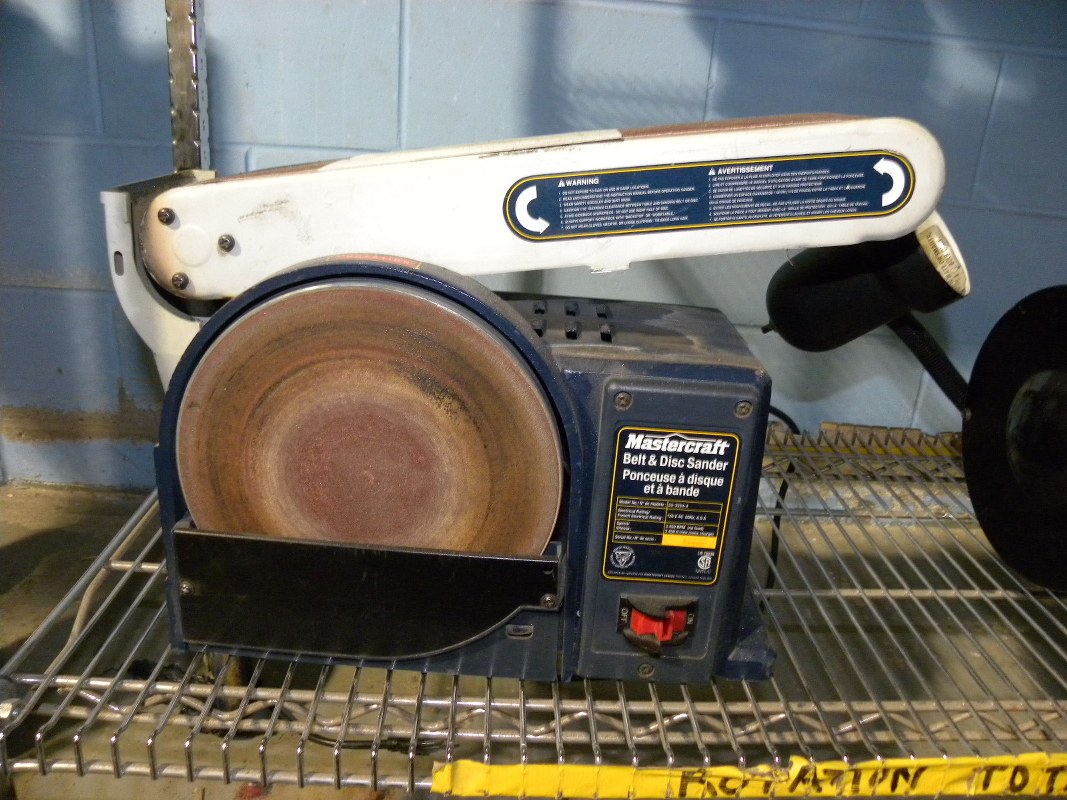MASTERCRAFT Belt Sander
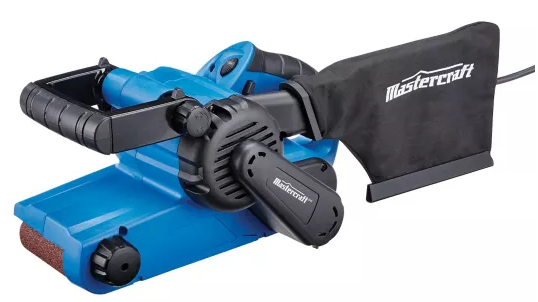
TECHNICAL SPECIFICATIONS
Rated voltage 120 V~, 60 HzRated power input 6 AVariable speed 0-1100 SFPMBelt size 3 x 21” (7.6 x 53.3 cm)
SAFETY GUIDELINES:
WARNING!Safety symbols in this Instruction Manual are used to flag possible dangers. The safety symbols and their explanations require your full understanding. The safety warnings do not, by themselves, eliminate any danger, nor are they substitutes for proper accident prevention measures.WARNING!This Safety Alert Symbol indicates caution, warning, or danger. Failure to obey a safety warning can result in serious injury to yourself or others. To reduce the risk of injury, fire, or electric shock, always follow the safety precautions.
KNOW YOUR TOOLTo operate this tool, carefully read this Instruction Manual and all labels affixed to the belt sander before using. Keep this instruction manual available for future reference.
IMPORTANTThis tool should only be serviced by a qualified service technician. For more information, call the toll free helpline at 1-800-689-9928.
READ ALL INSTRUCTIONS THOROUGHLY.SAVE THESE INSTRUCTIONS.GENERAL POWER TOOL SAFETY WARNINGS
WARNING!Read all safety warnings, instructions, illustrations and specifications provided with this power tool. Failure to follow all instructions listed below may result in electric shock, fire and/or serious injury.
SAVE ALL WARNINGS AND INSTRUCTIONS FOR FUTURE REFERENCE.The term “power tool” in the warnings refers to your mains-operated (corded) power tool or batteryoperated (cordless) power tool.
WORK AREA SAFETY
- Keep work area clean and well lit. Cluttered or dark areas invite accidents.
- Do not operate power tools in explosive atmospheres, such as in the presence of flammable liquids, gases or dust. Power tools create sparks which may ignite the dust or fumes.
- Keep children and bystanders away while operating a power tool. Distractions can cause you to lose control.
ELECTRICAL SAFETY
- Power tool plugs must match the outlet. Never modify the plug in any way. Do not use any adaptor plugs with earthed (grounded) power tools. Unmodified plugs and matching outlets will reduce risk of electric shock.
- Avoid body contact with earthed or grounded surfaces, such as pipes, radiators, ranges and refrigerators. There is an increased risk of electric shock if your body is earthed or grounded.
- Do not expose power tools to rain or wet conditions. Water entering a power tool will increase the risk of electric shock.
- Do not abuse the cord. Never use the cord for carrying, pulling or unplugging the power tool. Keep cord away from heat, oil, sharp edges or moving parts. Damaged or entangled cords increase the risk of electric shock.
- When operating a power tool outdoors, use an extension cord suitable for outdoor use. Use of a cord suitable for outdoor use reduces the risk of electric shock.
- If operating a power tool in a damp location is unavoidable, use a ground fault circuit interrupter (GFCI) protected supply. Use of an GFCI reduces the risk of electric shock.
PERSONAL SAFETY
- Stay alert, watch what you are doing and use common sense when operating a power tool. Do not use a power tool while you are tired or under the influence of drugs, alcohol or medication. A moment of inattention while operating power tools may result in serious personal injury.
- Use personal protective equipment. Always wear eye protection. Protective equipment such as a dust mask, non-skid safety shoes, hard hat or hearing protection used for appropriate conditions will reduce personal injuries.
- Prevent unintentional starting. Ensure the switch is in the off-position before connecting to power source and/or battery pack, picking up or carrying the tool. Carrying power tools with your finger on the switch or energising power tools that have the switch on invites accidents.
- Remove any adjusting key or wrench before turning the power tool on. A wrench or a key left attached to a rotating part of the power tool may result in personal injury.
- Do not overreach. Keep proper footing and balance at all times. This enables better control of the power tool in unexpected situations.
- Dress properly. Do not wear loose clothing or jewellery. Keep your hair and clothing away from moving parts. Loose clothes, jewellery or long hair can be caught in moving parts.
- If devices are provided for the connection of dust extraction and collection facilities, ensure these are connected and properly used. Use of dust collection can reduce dust-related hazards.
- Do not let familiarity gained from frequent use of tools allow you to become complacent and ignore tool safety principles. A careless action can cause severe injury within a fraction of a second.
POWER TOOL USE AND CARE
- Do not force the power tool. Use the correct power tool for your application. The correct power tool will do the job better and safer at the rate for which it was designed.
- Do not use the power tool if the switch does not turn it on and off. Any power tool that cannot be controlled with the switch is dangerous and must be repaired.
- Disconnect the plug from the power source and/or remove the battery pack, if detachable, from the power tool before making any adjustments, changing accessories, or storing power tools. Such preventive safety measures reduce the risk of starting the power tool accidentally.
- Store idle power tools out of the reach of children and do not allow persons unfamiliar with the power tool or these instructions to operate the power tool. Power tools are dangerous in the hands of untrained users.
- Maintain power tools and accessories. Check for misalignment or binding of moving parts, breakage of parts and any other condition that may affect the power tool’s operation. If damaged, have the power tool repaired before use. Many accidents are caused by poorly maintained power tools.
- Keep cutting tools sharp and clean. Properly maintained cutting tools with sharp cutting edges are less likely to bind and are easier to control.
- Use the power tool, accessories, tool bits, etc., in accordance with these instructions, taking into account the working conditions and the work to be performed. Use of the power tool for operations different from those intended could result in a hazardous situation.
- Keep handles and grasping surfaces dry, clean and free from oil and grease. Slippery handles and grasping surfaces do not allow for safe handling and control of the tool in unexpected situations.
SERVICE
Have your power tool serviced by a qualified repair person using only identical replacement parts. This will ensure that the safety of the power tool is maintained.
BELT SANDER SAFETY WARNINGS
Hold the power tool by insulated gripping surfaces, because the sanding surface may contact its own cord. Cutting a “live” wire may make exposed metal parts of the power tool “live” and could give the operator an electric shock.
ADDITIONAL SAFETY GUIDELINES FOR THE SANDER
The label on your tool may include the following symbols. The symbols and theirdefinitions are as follows:V …… VoltsA …….AmperesHz ……. Hertz

- A suitable breathing respirator must be worn while sanding lead paint, some woods and metal to avoid breathing the harmful/toxic dust or air.
- Always wear safety goggles and a dust mask when sanding, especially when sanding overhead.
- The machine is not suitable for wet sanding.
- Do not use sanding paper that is larger than needed. Extra paper extending beyond the sanding pad can cause serious lacerations.
- Secure the workpiece. A workpiece clamped with clamping devices or in a vice is held more securely than by hand.
- Attach the dust bag to the tool and empty it frequently. Do not throw sanding dust on an open fire, because materials in fine particle form may be explosive.
- If the replacement of the supply cord is necessary, this has to be done by the manufacturer or his agent in order to avoid a safety hazard.
PACKAGE CONTENTS:Belt sander, dust bag, 1 sanding belt (80 grit) and instruction manual
KEY PARTS DIAGRAM

Description
- Auxiliary handle
- Belt adjustment knob
- Variable-speed dial
- Lock-on button 8 Sanding belt
- Dust bag
- On/off switch
- Quick release tension lever
- Sanding belt
WARNING!
- Remove the belt sander from the package and examine it carefully. Do not discard the carton or any packaging material until all parts have been examined.
- If any part of the belt sander is missing or damaged, do not attach the tool to a power source or use the tool until the part has been repaired or replaced. Failure to heed this warning could result in serious injury.
OPERATING INSTRUCTIONS
INSTALL THE SANDING BELT (fig 1)
- Place sander on its side and pull the quick release tension lever out, as shown in fig 1.
- Insert the new belt around both rollers. Ensure the arrow on the inside of belt is pointing in the direction of rotation as indicated on housing.
- Once the belt is centred over the rollers and bottom plate, place quick release tension lever back in its original position to restore belt tension.
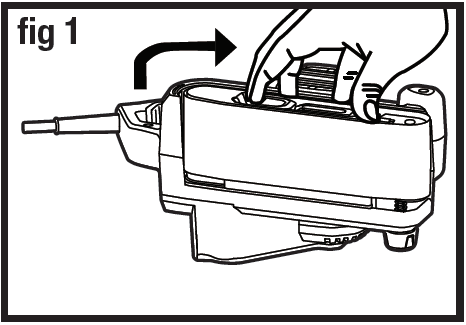
REMOVE THE SANDING BELT (fig 1)
- Place the sander on its side and rotate the quick release lever away from the sander, as shown in fig 1.
- With the sander on its side and the open side facing you, you can easily remove the belt.
INSTALL THE DUST BAG (fig 2)
- Unplug the sander from the power source.
- Align the slot on the dust bag with the rib on the tool, and then push the dust bag onto the tool until it locks into place.
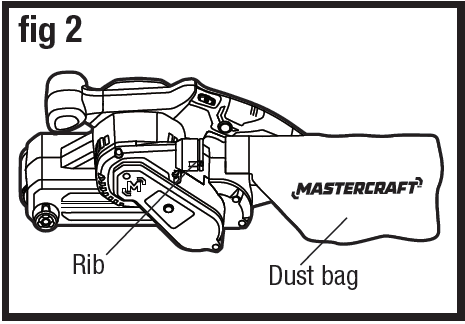
REMOVE THE DUST BAG (fig 2)
- Unplug the sander from the power source.
- Simply pull the dust bag away from the tool.
NOTICE: Close the zipper on the dust bag before operating the tool. The dust port on the tool can also accept a standard 1 1/4” (3.2 cm) vacuum tube for dust collection.WARNING: Always disconnect the sander from its power supply before attaching or removing sanding belt.
CLEAN THE DUST BAG (fig 3)
Check bag frequently and empty it before it gets full.To empty the dust bag, remove it from the tool. Open the zipper on back side of bag and empty the dust into waste container.

BELT ADJUSTMENT (fig 4)
Your sander features an automatic belt-control system that helps to keep the belt running in the centre of the rollers. The system has been preset at the factory, but may require adjustment to avoid frayed belt edges and wear on the sander frame when a belt is changed or an older belt stretches.
To adjust the belt (if necessary)
- Plug in the cord with the tool OFF.
- Hold handle of the sander with one hand and tilt the sander so that the belt is facing the operator.
- Squeeze the on/off switch to begin rotation of the belt.
- Turn the belt adjustment knob counter-clockwise to move the belt away from the sander motor. Turn the belt adjustment knob clockwise to move it towards the sander motor.
- Release the on/off switch and make sure that the belt has come to a complete stop before setting the tool down.
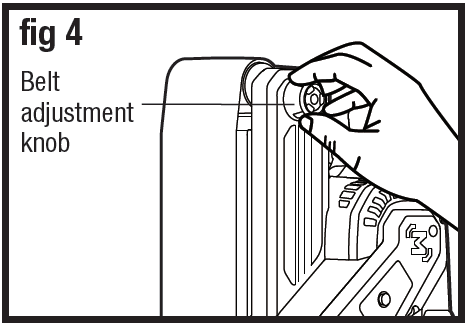
ADJUST THE SPEED (fig 5)
The variable-speed feature on this sander allows you to match the proper speed to the material being sanded.
- The variable-speed dial is used to adjust the speed of the sander.
- Turn the dial to increase or decrease the speed of the tool.
- Position “0” selects the slowest speed; position “5” selects the fastest speed. Adjust the speed for optimum performance.

TURN THE SANDER ON AND OFF (fig 6)
The tool can be turned on or off by squeezing or releasing the on/off switch.
LOCK-ON BUTTON (fig 6)
- The tool is also equipped with a lock-on button that allows continuous operation without continually holding the switch.
- To lock switch “ON”: squeeze switch, depress the lock-on button, and then release switch.
- To unlock switch: squeeze switch, then release switch without depressing the lock-on button.

GENERAL SANDING
- Be sure the cord is clear of the belt. Grasp the handles firmly.
- Start the sander off of the work surface to avoid gouging the belt. NEVER start or stop the sander with the belt in contact with the work surface.
- Place the heel of the sander on the work surface first. Then, with a forward motion, begin the sanding stroke as the tool is lowered onto the work surface.
- Use short, overlapping strokes, moving the sander slowly back and forth across the work surface.
- Avoid tilting or rocking the sander or sanding in one spot for too long. This causes gashes and hollows in the surface. Do not apply pressure to the sander. The sander is the weighted for the pressure needed. Too much pressure will overload the motor and reduce the belt speed.
- Begin sanding with a coarser grit sandpaper and gradually use finer grits, until the desired finish is achieved. Do not switch from a coarse grit to a very fine grit in one step.
- To stop, lift the sander from the work surface, then turn the sander off. Disengage the lock-on button. Allow the sander to come to a complete stop before setting it down. A moving belt will cause the sander to “run away” even if the motor is off.
WARNING!
- Before sanding small workpieces, ensure the workpiece is securely held in a vise or clamp. It’s recommended to work on the metal and wood.
- Sanding can produce clouds of fine dust particles that can ignite in the presence of sparks or an open flame. To avoid injury, always use your sander in a well-ventilated area.
- For your safety and to avoid damage, turn the sander on and off only when the sander is not in contact with a surface.
MAINTENANCE
BEFORE EACH USEBefore cleaning or performing any maintenance, make sure the sander has been disconnected from the power supply. Keep all ventilation openings clean. Avoid using solvents when cleaning plastic parts. Most plastics are susceptible to damage from various types of commercial solvents and may be damaged by their use. Use a clean cloth to remove dirt, oil and grease
REPLACE THE CARBON BRUSHES (fig 7)
1. Disconnect the plug from the power supply.2. Replace both carbon brushes when either has less than 1/4” (6.4 mm) length of carbon remaining, or if the spring or wire is damaged or burned.3. Using a slotted screwdriver, remove the black plastic cap on each side of the motor and carefully withdraw the spring-loaded brush assemblies.4. Keep brushes clean and sliding freely in their guide channels.5. Insert new brush assemblies into the guide channels with the carbon part going in first, being certain to fit the two metal “ears” into their slots in the channel. Remember to replace both end caps after inspecting or servicing the brushes.6. Tighten the caps snugly, but do not overtighten. The sander should be allowed to “run in” (run at no load without a cutter bit) for 5 minutes before use, to seat the new brushes properly.
WARNING!
• Do not let brake fluids, gasoline, petroleum-based products, penetrating oil, etc., come into contact with plastic parts. These substances contain chemicals that can damage, weaken, or destroy plastic.• To ensure safety and reliability, all repairs should be performed by a qualified service technician.• If the power cord is damaged, it must be replaced with an identical replacement part and be installed by an authorized service technician.
TROUBLESHOOTING
| Problem | Possible Causes | Solution |
|
The motor is overheating. |
Be sure the cooling vents are free from dust and obstacles. | Clean and clear the vents. Do not cover the vents with your hand during operation. |
|
Unsatisfactory sanding result. |
The sanding belt is worn. | Replace with a new sanding belt. |
| The sanding belt is not suitable for the workpiece. | Use the correct sanding belt. |
EXPLODED VIEW
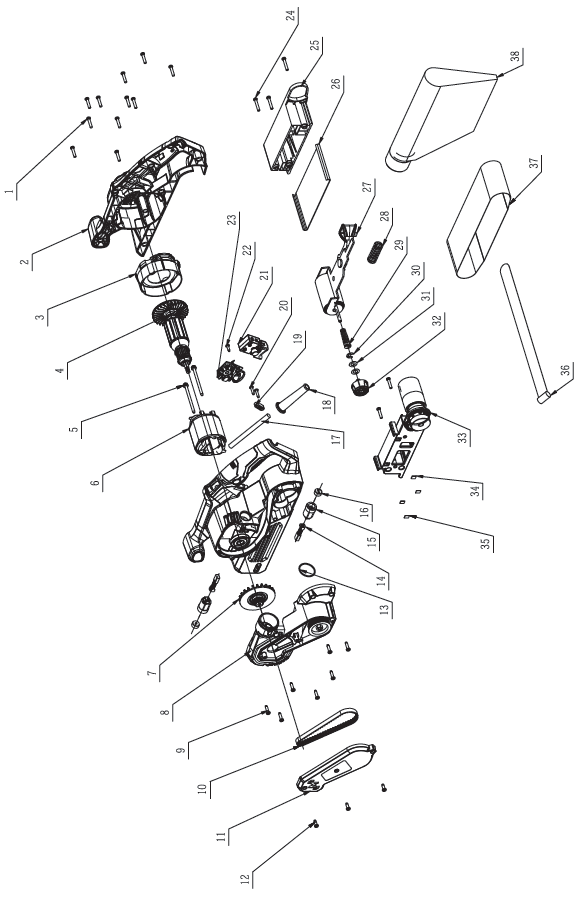
PARTS LIST

This Mastercraft product is guaranteed for three (3) years from the date of original retail purchase against defects in materials and workmanship, except for the following components:
a) Component A: Batteries, chargers and carrying case, which are guaranteed for a period of 2 years from the date of original retail purchase against defects in workmanship and materials; andb) Component B: Accessories, which are guaranteed for a period of 1-year from the date of original retail purchase against defects in workmanship and materials.
Subject to the conditions and limitations described below, this product, if returned to us with proof of purchase within the stated warranty period and if covered under this warranty, will be repaired or replaced (with the same model, or one of equal value or specification), at our option. We will bear the cost of any repair or replacement and any costs of labour relating there to.
These warranties are subject to the following conditions and limitations:
- a bill of sale verifying the purchase and purchase date must be provided;
- this warranty will not apply to any product or part thereof which is worn or broken or which has become inoperative due to abuse, misuse, accidental damage, neglect or lack of proper installation, operation or maintenance (as outlined in the applicable owner’s manual or operating instructions) or which is being used for industrial, professional, commercial or rental purposes;
- this warranty will not apply to normal wear and tear or to expendable parts or accessories that may be supplied with the product which are expected to become inoperative or unusable after a reasonable period of use;
- this warranty will not apply to routine maintenance and consumable items such as, but not limited to, fuel, lubricants, vacuum bags, blades, belts, sandpaper, bits, fluids, tune-ups or adjustments;
- this warranty will not apply where damage is caused by repairs made or attempted by others (i.e., persons not authorized by the manufacturer);
- this warranty will not apply to any product that was sold to the original purchaser as a reconditioned or refurbished product (unless otherwise specified in writing);
- this warranty will not apply to any product or part thereof if any part from another manufacturer is installed therein or any repairs or alterations have been made or attempted by unauthorized persons;
- this warranty will not apply to normal deterioration of the exterior finish, such as, but not limited to, scratches, dents, paint chips, or to any corrosion or discolouring by heat, abrasive and chemical cleaners; and
- this warranty will not apply to component parts sold by and identified as the product of another company, which shall be covered under the product manufacturer’s warranty, if any.
WARRANTY
Additional LimitationsThis warranty applies only to the original purchaser and may not be transferred. Neither the retailer nor the manufacturer shall be liable for any other expense, loss or damage, including, without limitation, any indirect, incidental, consequential or exemplary damages arising in connection with the sale, use or inability to use this product.
Notice to ConsumerThis warranty gives you specific legal rights, and you may have other rights, which may vary from province to province. The provisions contained in this warranty are not intended to limit, modify, take away from, disclaim or exclude any statutory warranties set forth in any applicable provincial or federal legislation.
Made in ChinaImported byMastercraft Canada Toronto, Canada M4S 2B8

[xyz-ips snippet=”download-snippet”]

